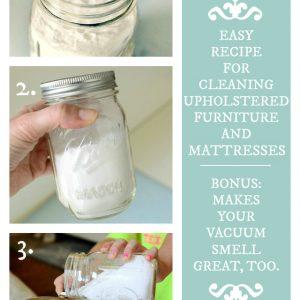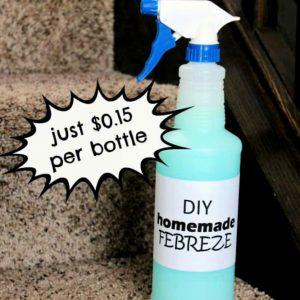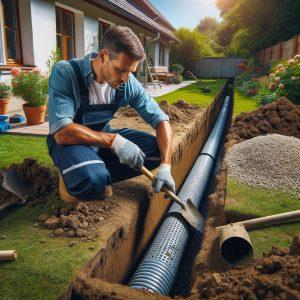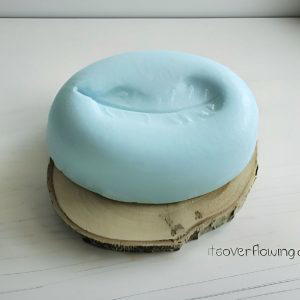Rust can be a persistent problem for metal items, causing aesthetic degradation and potentially compromising structural integrity. The importance of removing rust from metal quickly cannot be overstated, as it can prevent deeper structural issues and extend the service life of metal objects.
In this post, we’ll explore tested and approved methods for removing rust from metal surfaces, providing you with practical solutions to combat this common issue effectively. From utilizing white vinegar to steel and aluminum abrasives, we’ll cover various approaches to help you restore metal items to their former glory. Whether it’s garden tools or household items, knowing how to remove rust from metal is a valuable skill that can prolong the lifespan and visual appeal of your cherished possessions.
With these insights, you’ll be equipped to address rust-related challenges and preserve the quality of your metal belongings.

Understanding Rust and Its Impact on Metal
Rust, the common name for the process of corrosion of iron and its alloys, occurs when metal is exposed to moisture and oxygen. The chemical process of rust formation begins with the reaction of iron with oxygen in the presence of water or moisture, leading to the formation of iron oxide.
Formation of Rust on Metal
The formation of rust on metal occurs through a process called oxidation, where iron atoms lose electrons to oxygen atoms, resulting in the production of iron oxide. This process is accelerated by the presence of water, which facilitates the movement of electrons between iron and oxygen. When metal is exposed to moisture and oxygen over time, rust gradually forms, starting from microscopic defects in the metal’s surface and eventually spreading across the entire surface.
Effects of Rust on Metal
Rust can have detrimental effects on metal, compromising its structural integrity and longevity. The accumulation of rust can lead to the weakening of metal structures, causing structural damage and posing safety hazards. Additionally, rust can reduce the lifespan of metal by accelerating deterioration and corrosion. When rust forms on metal surfaces that come into contact with skin or food, it can also pose potential health hazards, especially if ingested or inhaled.
Remember, understanding the chemical process of rust formation and its negative impact on metal is crucial in implementing effective rust removal and prevention strategies.
Methods for Removing Rust from Metal
Rust can be a persistent problem on metal surfaces, but there are a variety of effective methods for removing it. From chemical solutions to mechanical techniques, and preventive measures, here are some approaches to consider.
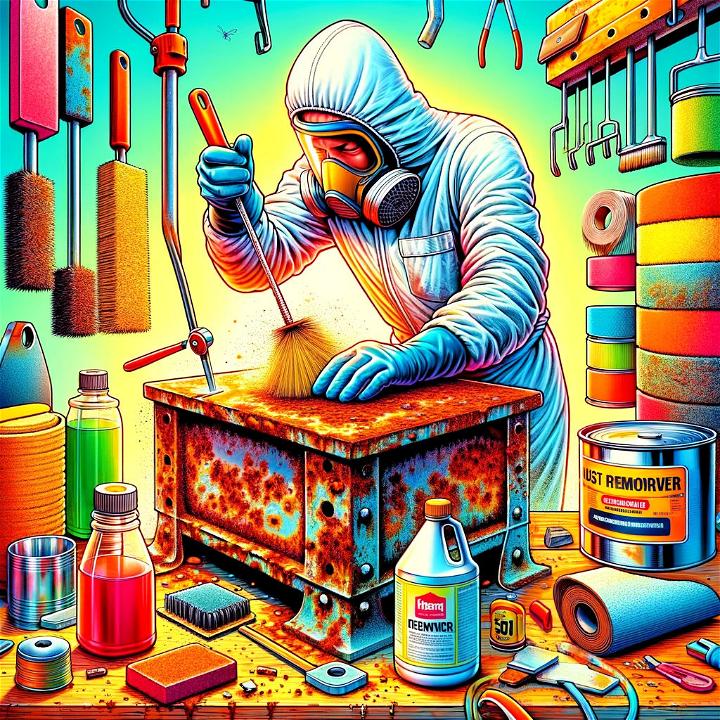
Chemical Rust Removal Methods
Chemical solutions such as vinegar, rust dissolvers, and rust converters offer effective means to remove rust from metal surfaces. A popular DIY approach involves creating a vinegar bath by submerging the rusty item in white vinegar and allowing it to soak overnight. After soaking, the rust can be scrubbed away using a wire brush or steel wool. Products like rust converters chemically alter rust into a more stable form, preventing further corrosion. When using chemical solutions, it’s important to follow safety guidelines, including wearing protective gloves and ensuring proper ventilation in the work area.
Mechanical Rust Removal Techniques
Mechanical approaches to rust removal involve physical abrasion to eliminate rust from metal surfaces. Wire brushing, sanding, and the use of abrasive materials like steel wool or sandpaper are effective mechanical techniques. For light rust or surface rust, a wire brush or steel wool can be used to scrub away the rust. However, for more extensive rust, sanding may be required to completely remove the corrosion. It’s important to use appropriate safety equipment, such as goggles and gloves, when employing mechanical rust removal techniques.
Preventive Measures to Avoid Rust
Preventing rust formation is equally important as removing existing rust. Protective coatings, such as paint or specialized rust-inhibiting products, can create a barrier against moisture and oxygen that lead to rust formation. Regular maintenance, including cleaning and drying metal surfaces, can help prevent the build-up of corrosive agents. Additionally, considering environmental factors, such as exposure to saltwater or high humidity, can guide preventive measures to avoid rust on metal surfaces.
Remember, choosing the right rust removal method depends on the severity of rust and the type of metal, so consider these factors when deciding on the most suitable approach.
Best Practices and Safety Precautions
Before beginning any rust removal process, it’s essential to prioritize safety and environmental considerations. Taking proper safety precautions and being mindful of the environmental impact of rust removal methods are crucial elements of the rust removal process.
Safety Precautions for Chemical Rust Removal
When opting for chemical rust removal methods, it’s important to adhere to strict safety measures. Protective gear such as safety goggles, gloves, and a dust mask is essential to shield oneself from potentially harmful chemicals. Additionally, working in a well-ventilated area or using protective respiratory equipment is crucial to minimize inhalation of fumes. Proper disposal of used chemical solutions is also necessary to prevent environmental contamination and harm.
Environmental Considerations
Considering the environmental impact of rust removal is pivotal. Opting for eco-friendly rust removal methods and responsible disposal of rust-infused materials can significantly minimize environmental harm. By utilizing environmentally safe rust removal products and ensuring the proper disposal of waste materials, one can contribute to sustainable and eco-conscious rust removal practices.
Remember to wear protective gear, such as gloves and safety glasses when working with rust removal methods, especially chemical solutions.
Expert Tips and Recommendations
When it comes to rust removal, metal restoration specialists recommend a variety of products, techniques, and maintenance practices to effectively eliminate rust and prevent its recurrence. One commonly recommended product is white vinegar, known for its acidic properties that can dissolve rust. Additionally, lemon juice paste, baking soda, and cream of tartar are suggested for their rust removal capabilities. These insights from experts in the field of metal restoration provide a range of effective solutions for tackling rust on metal surfaces.
Insights from Metal Restoration Specialists
Metal restoration specialists emphasize the importance of regular maintenance to prevent rust formation. They recommend using rust-resistant coatings such as zinc or galvanized plating to protect metal from corroding. Additionally, frequent inspections and prompt treatment of any signs of rust are essential to preserving the integrity of metal objects. By staying proactive in maintenance practices, metal owners can extend the lifespan of their items and minimize the impact of rust.
Community-Sourced DIY Rust Removal Methods
DIY enthusiasts and metalworkers have shared practical tips and success stories for removing rust from different types of metal objects. Commonly suggested methods include submerging the rusty item in white vinegar overnight, using a combination of salt and distilled white vinegar, or employing aluminum foil and a mild acid like white vinegar. These community-sourced DIY rust removal methods offer valuable insights and real-life experiences for effectively addressing rust issues without the need for professional expertise. Engaging with these shared experiences can provide individuals with effective and accessible solutions for rust removal.
By incorporating expert recommendations and community-sourced DIY methods, individuals can effectively combat rust and preserve the quality and longevity of their metal belongings.
FAQs
When it comes to removing rust from metal, people often have a range of questions about the process. Here are some of the most frequently asked questions about removing rust from metal surfaces.
What are the common methods to remove rust from metal?
There are several common methods to remove rust from metal. Some popular techniques include using white vinegar, baking soda and water paste, or commercial rust-removal products. Each method has its own set of advantages and may be more suitable for certain types of metal or degrees of rust.
Can I use household items to remove rust from metal?
Yes, many household items like white vinegar, baking soda, or lemon juice can be used to effectively remove rust from metal surfaces. These natural remedies are often preferred by individuals looking for non-toxic and environmentally friendly rust removal solutions.
Is it possible to prevent rust from forming on metal surfaces?
Preventing rust from forming on metal surfaces involves proper maintenance and protective measures. Applying a rust-resistant coating, such as paint or specialized metal treatments, can help shield the metal from moisture and oxygen, which are the primary causes of rust formation.
What safety precautions should I take when removing rust from metal?
When removing rust from metal, it’s important to consider safety precautions. Using protective gloves, goggles, and working in a well-ventilated area are essential for minimizing exposure to rust particles and any chemicals used in the process.
How long does it take to remove rust from metal?
The time it takes to remove rust from metal depends on the severity of the rust and the method being used. For minor surface rust, the process can be relatively quick, while deeply embedded rust may require more time and effort to completely eradicate.
Conclusion
In conclusion, removing rust from metal is a straightforward process that can be accomplished using household items like white vinegar, salt, and aluminum foil. By following the simple yet effective methods outlined in this guide, you can restore your metal possessions to their former glory and prevent further corrosion.
Regular maintenance is crucial in preventing rust from taking hold, as it not only prolongs the lifespan of metal items but also enhances their aesthetic appeal. Take proactive steps to address any signs of rust promptly and apply the learned techniques to safeguard your valuable possessions for years to come.


